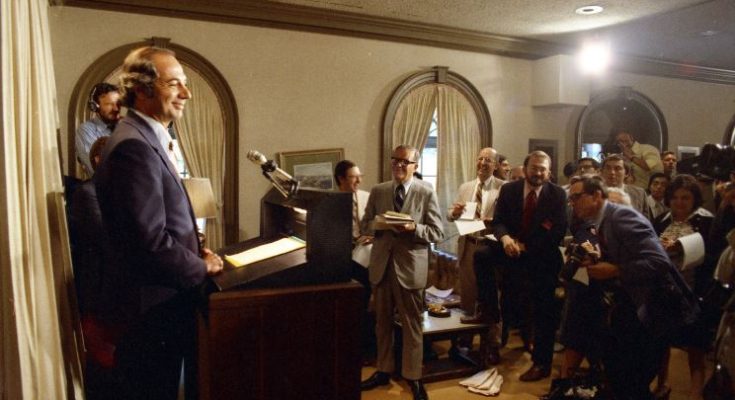A former journalist, Mr. Nessen sought to rebuild the image of the White House after the Watergate cover-ups toppled Richard Nixon.
Ford’s first press secretary, Jerald terHorst, left amid disagreement over Ford’s decision to pardon Nixon for possible criminal charges related to the White House’s extensive cover-ups, which began with a break-in in 1972 at the Democratic National Committee offices at Washington’s Watergate complex.
Ford already felt at ease with Mr. Nessen. Less than three weeks after assuming the presidency, Ford joined a journalist-filled barbecue hosted by Mr. Nessen, then at NBC, at his Bethesda home. The reporters serenaded Ford with a Watergate-spoof version of the song “Thanks for the Memory.”
Ford also wanted a media veteran who knew the boundaries of the press secretary job, Mr. Nessen recalled. “Who gives a damn what the press secretary thinks? You’re not a policymaker. You’re not a political figure,” Mr. Nessen said in a 2009 interview for the Gerald Ford Oral History Project. “You’re a spokesman, literally.”
To his former colleagues, Mr. Nessen promised transparency and access. He quipped: “I’m a Ron, but not a Ziegler,” referring to Nixon’s press secretary, Ronald Ziegler, who was widely seen by the media as a Watergate-era obstructionist.
“I tried to do everything that Ziegler didn’t do, and not do the things that Ziegler did,” Mr. Nessen said. He drew the line at offering insider tidbits or analysis that he felt went beyond his role.
When Ford opposed a federal bailout for near-bankrupt New York in 1975 — summed up by the Daily News headline “Ford To City: Drop Dead” — Mr. Nessen stuck to White House talking points. “You can’t go on freely spending more money every year that you take in,” he told reporters. After a Secret Service agent subdued Lynette “Squeaky” Fromme in an apparent assassination attempt on Ford in 1975 in California, Mr. Nessen refused to leak behind-the-scenes details not first cleared by Ford’s staff.
Ford, a former football star at the University of Michigan, gained a new reputation as an accident waiting to happen with incidents such as tumbling down the stairs of Air Force One while visiting Austria in 1975.
For Chevy Chase at “Saturday Night Live,” the foibles were comic gold. He led skits playing Ford as bumbling and stumbling. “[Ford] never said anything, but I just sensed that he thought that he was being parodied unjustifiably,” Mr. Nessen said in the oral history.
Ford invited Chase to play tennis at the White House. Mr. Nessen saw an opportunity — looking ahead to Ford’s 1976 election campaign to remain in office.
Mr. Nessen began negotiations with “Saturday Night Live” creator and producer Lorne Michaels. On April 17, 1976, Mr. Nessen was the “SNL” host (introducing a young comedian, Billy Crystal) and Ford, in a prerecorded video, became the first president to utter the line: “Live from New York, it’s Saturday Night!”
Mr. Nessen fully leaned into the lampooning. He said his job in Washington was to “explain what the president said, what the president meant, what the president bumped his head on and what the president mispronounced.”
The show stirred some complaints about cheapening the dignity of the presidency — even though Nixon, as a candidate in 1968, appeared on the TV comedy revue “Rowan & Martin’s Laugh In” to give its catchphrase, “Sock it to me.”
Many other commentators recognized the powerful convergence of politics and pop culture. The Ford appearance on “Saturday Night Live” became widely regarded as a landmark in modern campaigning. (Ford lost to Jimmy Carter in the 1976 election.)
The show turned Mr. Nessen into a fleeting celebrity with his own brand of dark humor. At a post-broadcast party, Mr. Nessen danced with actress Louise Lasser, the Chicago Tribune reported, and was asked: “Is it show business from now on?”
“No, back to politics,” he replied. “Nuclear war, that sort of thing.”
Ronald Harold Nessen was born in Washington on May 25, 1934. His family ran a variety store.
He was hired by NBC in 1962 with assignments that included five tours covering the Vietnam War and was seriously wounded in 1966 during a battle. NBC sound engineer Curtis Mitchell rushed to his aid. “He held Ron while blood gushed from his chest,” wrote former NBC Saigon news chief Ron Steinman in “Inside Television’s First War” (2002). “Grenade fragments had entered his body and he went into shock.” A military helicopter brought Mr. Nessen to a field hospital.
In 1975, Mr. Nessen was called on to brief reporters about the fall of Saigon (now Ho Chi Minh City) by North Vietnamese forces. Mr. Nessen and Secretary of State Henry Kissinger were in the briefing room. “The first thing I said at the briefing was, ‘All the Americans are out of Saigon. The evacuation is complete,’” Mr. Nessen recalled.
They learned that 135 Marines were still inside the U.S. Embassy compound. Kissinger was furious at the error, recounted Mr. Nessen, who was ordered to revise his statement.
After Ford’s presidency, Mr. Nessen was executive vice president at the public relations firm Marston & Rothenberg in the early 1980s and then worked as vice president for news at Mutual Broadcasting from 1984 to 1992.
His marriages, to Sandra Frey, Young Hi Song and Johanna Neuman, ended in divorce. A son from his first marriage, Stephen, died as a child. Survivors include a daughter from his first marriage, Caren; a son from his second marriage, Edward; a sister; two grandchildren; and three great-grandchildren.
In a memoir of his press secretary years, “It Sure Looks Different from the Inside” (1978), Mr. Nessen described his sobering last appearance before the press corps.
“It was over. My last briefing,” he wrote. “I hesitated a moment at the podium, thinking one of the reporters might say, ‘Good luck’ or ‘See you around.’ I even thought I might get applause. But there was nothing.”





